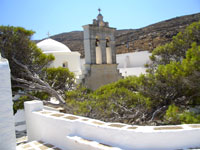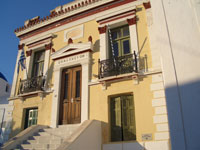 SERIFOS HISTORY SERIFOS HISTORY
 Like many other Cycladic islands, Serifos has a long and rich history. According to mythology, the island of Seirfos was inhabited by the Cyclops, who are said to have built several of the monuments on the island, such as the White Tower and the Walls of Liomandras. Like many other Cycladic islands, Serifos has a long and rich history. According to mythology, the island of Seirfos was inhabited by the Cyclops, who are said to have built several of the monuments on the island, such as the White Tower and the Walls of Liomandras.
Serifos is the location where yet another mythological tale took place. Akrisios, the King of Argos, was told by an oracle that his grandson would be responsible for his downfall, so he locked his daughter Danae in the palace. In spite of this precaution, Zeus, who was in love with Danae, managed to leave her with child by appearing in the form of golden rain. Once Danae gave birth to her son Perseas, Akrisios put both of them into a box and threw it into the sea.
The box washed up on the shores of Serfios and was found by King Polydektis, who also fell in love with Danae. Wanting to get rid of Perseas, Polydektis sent him to kill Medusa, the mythological creature who turned people into stone by looking at them. With the help of the god, Perseas killed the monster. Athena gave him a shield with which he could reflect Medusa's gaze and successfully attack her. Returning with the head of Medusa, Perseas turned Polydektis into stone.
 If there is some historical truth in mythology, then the first inhabitants - Kings Polydektis, his brother Diktis and his people - were Aioleans from Thessaly. During the Prehistoric Times, tribes from Crete lived on the island. Phoenicians and Myceneans followed. In the 7th - 6th century BC, the Ionians used the iron on Serifos to become a great commercial and political center. At the period of the Persian Wars, Serifos was part of the Athenian Alliance. The island continued to be active during the Hellenistic Era. If there is some historical truth in mythology, then the first inhabitants - Kings Polydektis, his brother Diktis and his people - were Aioleans from Thessaly. During the Prehistoric Times, tribes from Crete lived on the island. Phoenicians and Myceneans followed. In the 7th - 6th century BC, the Ionians used the iron on Serifos to become a great commercial and political center. At the period of the Persian Wars, Serifos was part of the Athenian Alliance. The island continued to be active during the Hellenistic Era.
In 146 BC, Serifos came under Roman Rule and was used as a place of exile for those who were against the Romans. In the Byzantine Era, the island was used as a place of exile for political dissidents, while during the Venetian Rule, Serifos flourished commercially, because of the slaves that were brought to work in the iron mines. The Ottoman Rule was a time of great decline. Serifos took part in the Greek Revolution and was liberated along with the other Cyclades Islands in 1830.
From then on, iron mining played a major role in the island's economy, while agriculture, fishing and tourism were also important factors in Serifos' survival. In recent years, Serifos has developed into one of the up and coming holiday spots in Greece, due to its charming Cycladic characteristics, splendid beaches and wonderful hospitality.
|
|
 Like many other Cycladic islands, Serifos has a long and rich history. According to mythology, the island of Seirfos was inhabited by the Cyclops, who are said to have built several of the monuments on the island, such as the White Tower and the Walls of Liomandras.
Like many other Cycladic islands, Serifos has a long and rich history. According to mythology, the island of Seirfos was inhabited by the Cyclops, who are said to have built several of the monuments on the island, such as the White Tower and the Walls of Liomandras.  If there is some historical truth in mythology, then the first inhabitants - Kings Polydektis, his brother Diktis and his people - were Aioleans from Thessaly. During the Prehistoric Times, tribes from Crete lived on the island. Phoenicians and Myceneans followed. In the 7th - 6th century BC, the Ionians used the iron on Serifos to become a great commercial and political center. At the period of the Persian Wars, Serifos was part of the Athenian Alliance. The island continued to be active during the Hellenistic Era.
If there is some historical truth in mythology, then the first inhabitants - Kings Polydektis, his brother Diktis and his people - were Aioleans from Thessaly. During the Prehistoric Times, tribes from Crete lived on the island. Phoenicians and Myceneans followed. In the 7th - 6th century BC, the Ionians used the iron on Serifos to become a great commercial and political center. At the period of the Persian Wars, Serifos was part of the Athenian Alliance. The island continued to be active during the Hellenistic Era.